Project on Training for Decision Making Systems Software
VerifiedAdded on 2023/04/19
|16
|4364
|392
Report
AI Summary
This report focuses on a training project for implementing decision-making systems software at the Phoenix Power Company in Oman. It details the project's planning and control of quality, emphasizing goal setting, progress measurement, and action implementation based on the PMBOK framework. The report outlines human resource strategies, including recruitment, training, and team-building practices to ensure productive outcomes. It covers procurement processes, outlining input documents, tools, techniques, and outputs to manage resources and expert judgment effectively. Communication strategies, including sender-receiver dynamics, are discussed. Finally, the report highlights stakeholder management, encompassing identification, analysis, and engagement to ensure project success. The report provides a comprehensive overview of the project's key elements and management strategies.

Running head: PROJECT ON TRAINING FOR THE USE OF DECISION MAKING SYSTEMS SOFTWARE
Project on Training for the Use of Decision Making Systems Software
Name of the Student
Name of the University
Author’s note
Project on Training for the Use of Decision Making Systems Software
Name of the Student
Name of the University
Author’s note
Paraphrase This Document
Need a fresh take? Get an instant paraphrase of this document with our AI Paraphraser
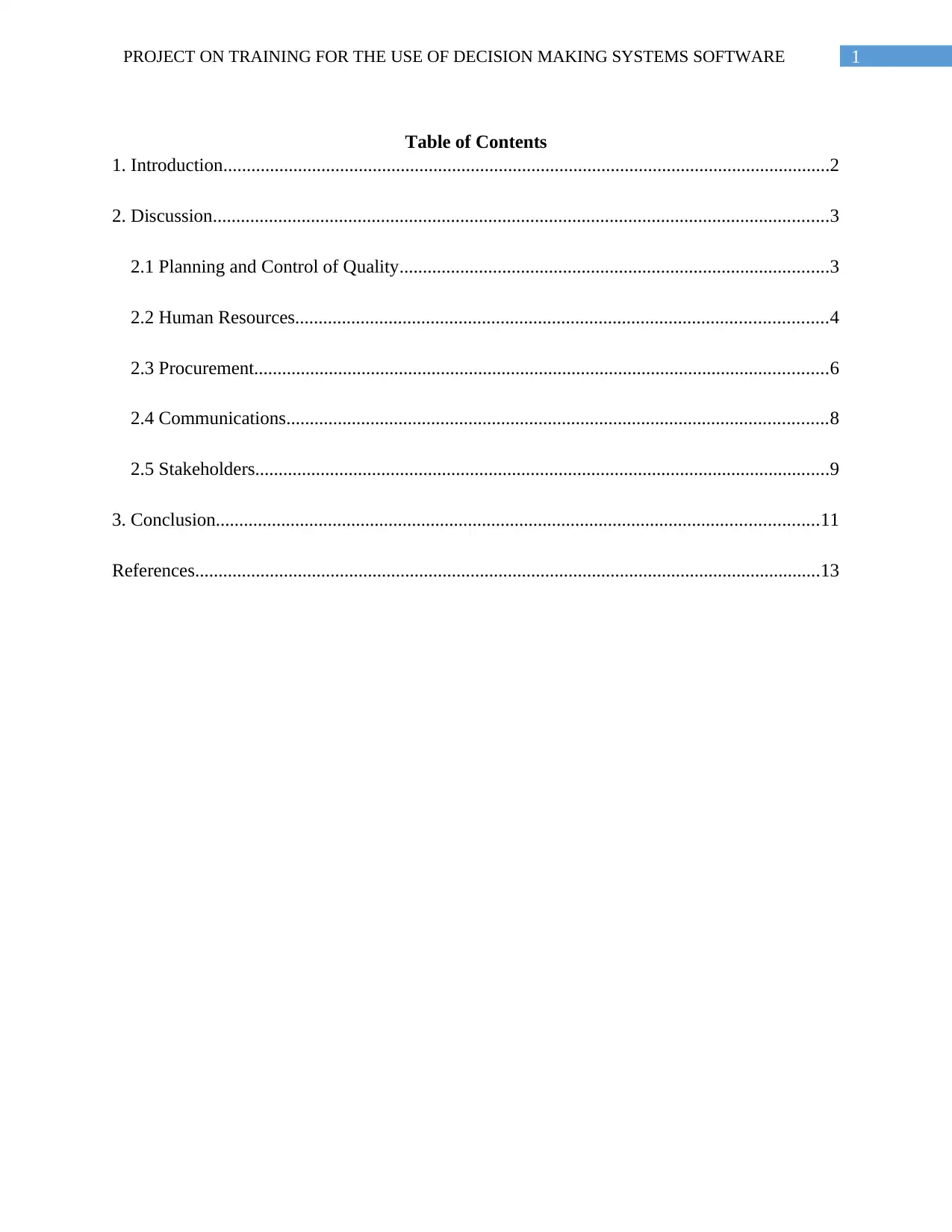
1PROJECT ON TRAINING FOR THE USE OF DECISION MAKING SYSTEMS SOFTWARE
Table of Contents
1. Introduction..................................................................................................................................2
2. Discussion....................................................................................................................................3
2.1 Planning and Control of Quality............................................................................................3
2.2 Human Resources..................................................................................................................4
2.3 Procurement...........................................................................................................................6
2.4 Communications....................................................................................................................8
2.5 Stakeholders...........................................................................................................................9
3. Conclusion.................................................................................................................................11
References......................................................................................................................................13
Table of Contents
1. Introduction..................................................................................................................................2
2. Discussion....................................................................................................................................3
2.1 Planning and Control of Quality............................................................................................3
2.2 Human Resources..................................................................................................................4
2.3 Procurement...........................................................................................................................6
2.4 Communications....................................................................................................................8
2.5 Stakeholders...........................................................................................................................9
3. Conclusion.................................................................................................................................11
References......................................................................................................................................13
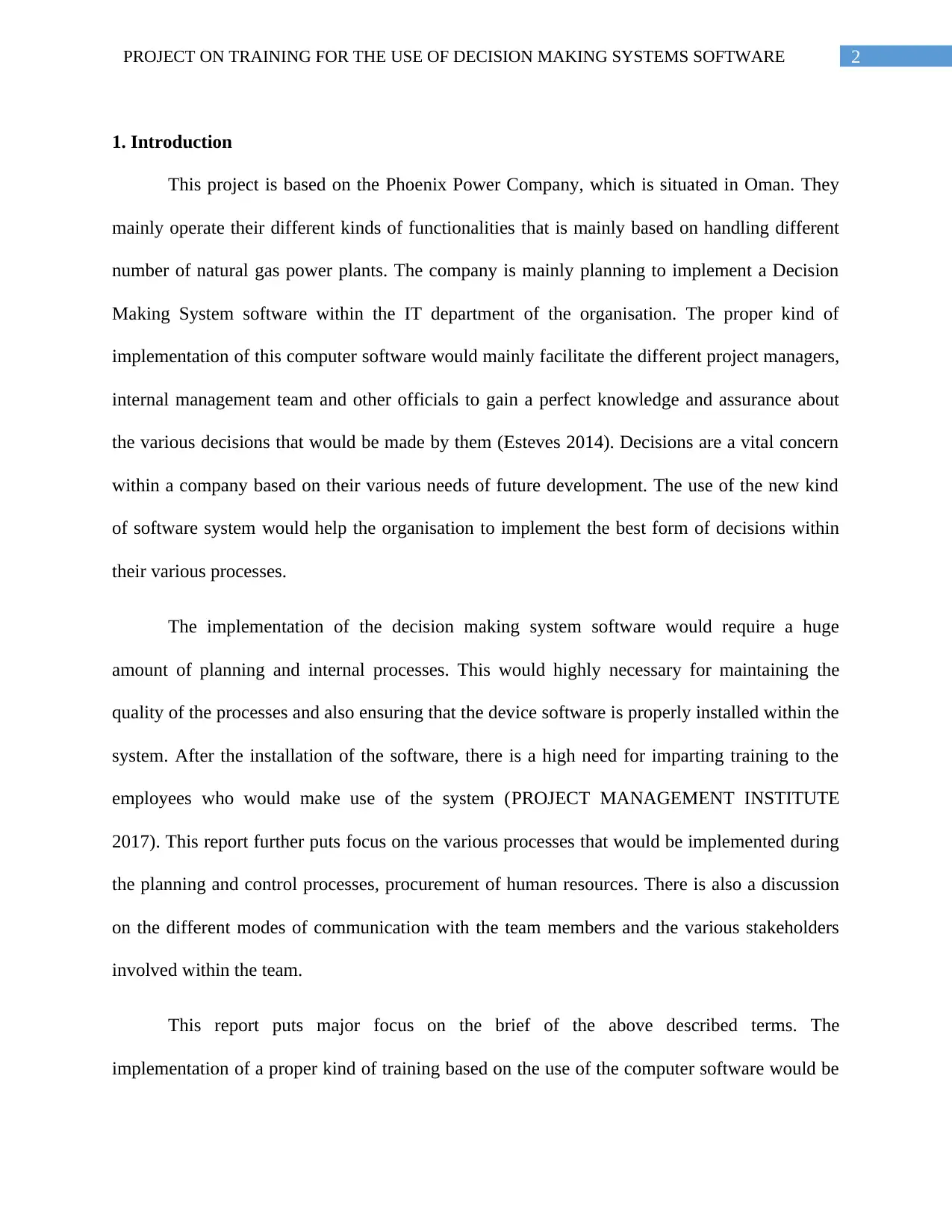
2PROJECT ON TRAINING FOR THE USE OF DECISION MAKING SYSTEMS SOFTWARE
1. Introduction
This project is based on the Phoenix Power Company, which is situated in Oman. They
mainly operate their different kinds of functionalities that is mainly based on handling different
number of natural gas power plants. The company is mainly planning to implement a Decision
Making System software within the IT department of the organisation. The proper kind of
implementation of this computer software would mainly facilitate the different project managers,
internal management team and other officials to gain a perfect knowledge and assurance about
the various decisions that would be made by them (Esteves 2014). Decisions are a vital concern
within a company based on their various needs of future development. The use of the new kind
of software system would help the organisation to implement the best form of decisions within
their various processes.
The implementation of the decision making system software would require a huge
amount of planning and internal processes. This would highly necessary for maintaining the
quality of the processes and also ensuring that the device software is properly installed within the
system. After the installation of the software, there is a high need for imparting training to the
employees who would make use of the system (PROJECT MANAGEMENT INSTITUTE
2017). This report further puts focus on the various processes that would be implemented during
the planning and control processes, procurement of human resources. There is also a discussion
on the different modes of communication with the team members and the various stakeholders
involved within the team.
This report puts major focus on the brief of the above described terms. The
implementation of a proper kind of training based on the use of the computer software would be
1. Introduction
This project is based on the Phoenix Power Company, which is situated in Oman. They
mainly operate their different kinds of functionalities that is mainly based on handling different
number of natural gas power plants. The company is mainly planning to implement a Decision
Making System software within the IT department of the organisation. The proper kind of
implementation of this computer software would mainly facilitate the different project managers,
internal management team and other officials to gain a perfect knowledge and assurance about
the various decisions that would be made by them (Esteves 2014). Decisions are a vital concern
within a company based on their various needs of future development. The use of the new kind
of software system would help the organisation to implement the best form of decisions within
their various processes.
The implementation of the decision making system software would require a huge
amount of planning and internal processes. This would highly necessary for maintaining the
quality of the processes and also ensuring that the device software is properly installed within the
system. After the installation of the software, there is a high need for imparting training to the
employees who would make use of the system (PROJECT MANAGEMENT INSTITUTE
2017). This report further puts focus on the various processes that would be implemented during
the planning and control processes, procurement of human resources. There is also a discussion
on the different modes of communication with the team members and the various stakeholders
involved within the team.
This report puts major focus on the brief of the above described terms. The
implementation of a proper kind of training based on the use of the computer software would be
⊘ This is a preview!⊘
Do you want full access?
Subscribe today to unlock all pages.

Trusted by 1+ million students worldwide
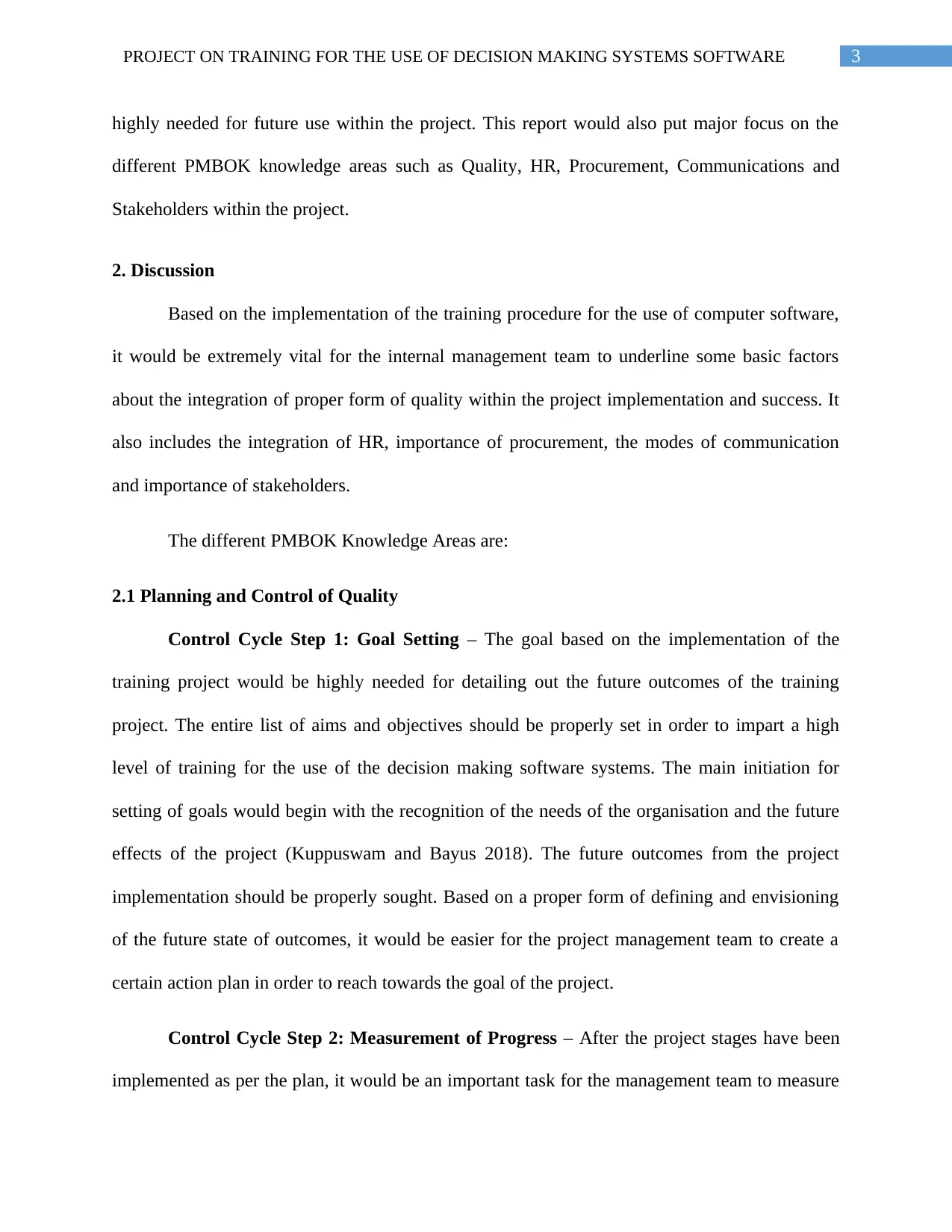
3PROJECT ON TRAINING FOR THE USE OF DECISION MAKING SYSTEMS SOFTWARE
highly needed for future use within the project. This report would also put major focus on the
different PMBOK knowledge areas such as Quality, HR, Procurement, Communications and
Stakeholders within the project.
2. Discussion
Based on the implementation of the training procedure for the use of computer software,
it would be extremely vital for the internal management team to underline some basic factors
about the integration of proper form of quality within the project implementation and success. It
also includes the integration of HR, importance of procurement, the modes of communication
and importance of stakeholders.
The different PMBOK Knowledge Areas are:
2.1 Planning and Control of Quality
Control Cycle Step 1: Goal Setting – The goal based on the implementation of the
training project would be highly needed for detailing out the future outcomes of the training
project. The entire list of aims and objectives should be properly set in order to impart a high
level of training for the use of the decision making software systems. The main initiation for
setting of goals would begin with the recognition of the needs of the organisation and the future
effects of the project (Kuppuswam and Bayus 2018). The future outcomes from the project
implementation should be properly sought. Based on a proper form of defining and envisioning
of the future state of outcomes, it would be easier for the project management team to create a
certain action plan in order to reach towards the goal of the project.
Control Cycle Step 2: Measurement of Progress – After the project stages have been
implemented as per the plan, it would be an important task for the management team to measure
highly needed for future use within the project. This report would also put major focus on the
different PMBOK knowledge areas such as Quality, HR, Procurement, Communications and
Stakeholders within the project.
2. Discussion
Based on the implementation of the training procedure for the use of computer software,
it would be extremely vital for the internal management team to underline some basic factors
about the integration of proper form of quality within the project implementation and success. It
also includes the integration of HR, importance of procurement, the modes of communication
and importance of stakeholders.
The different PMBOK Knowledge Areas are:
2.1 Planning and Control of Quality
Control Cycle Step 1: Goal Setting – The goal based on the implementation of the
training project would be highly needed for detailing out the future outcomes of the training
project. The entire list of aims and objectives should be properly set in order to impart a high
level of training for the use of the decision making software systems. The main initiation for
setting of goals would begin with the recognition of the needs of the organisation and the future
effects of the project (Kuppuswam and Bayus 2018). The future outcomes from the project
implementation should be properly sought. Based on a proper form of defining and envisioning
of the future state of outcomes, it would be easier for the project management team to create a
certain action plan in order to reach towards the goal of the project.
Control Cycle Step 2: Measurement of Progress – After the project stages have been
implemented as per the plan, it would be an important task for the management team to measure
Paraphrase This Document
Need a fresh take? Get an instant paraphrase of this document with our AI Paraphraser
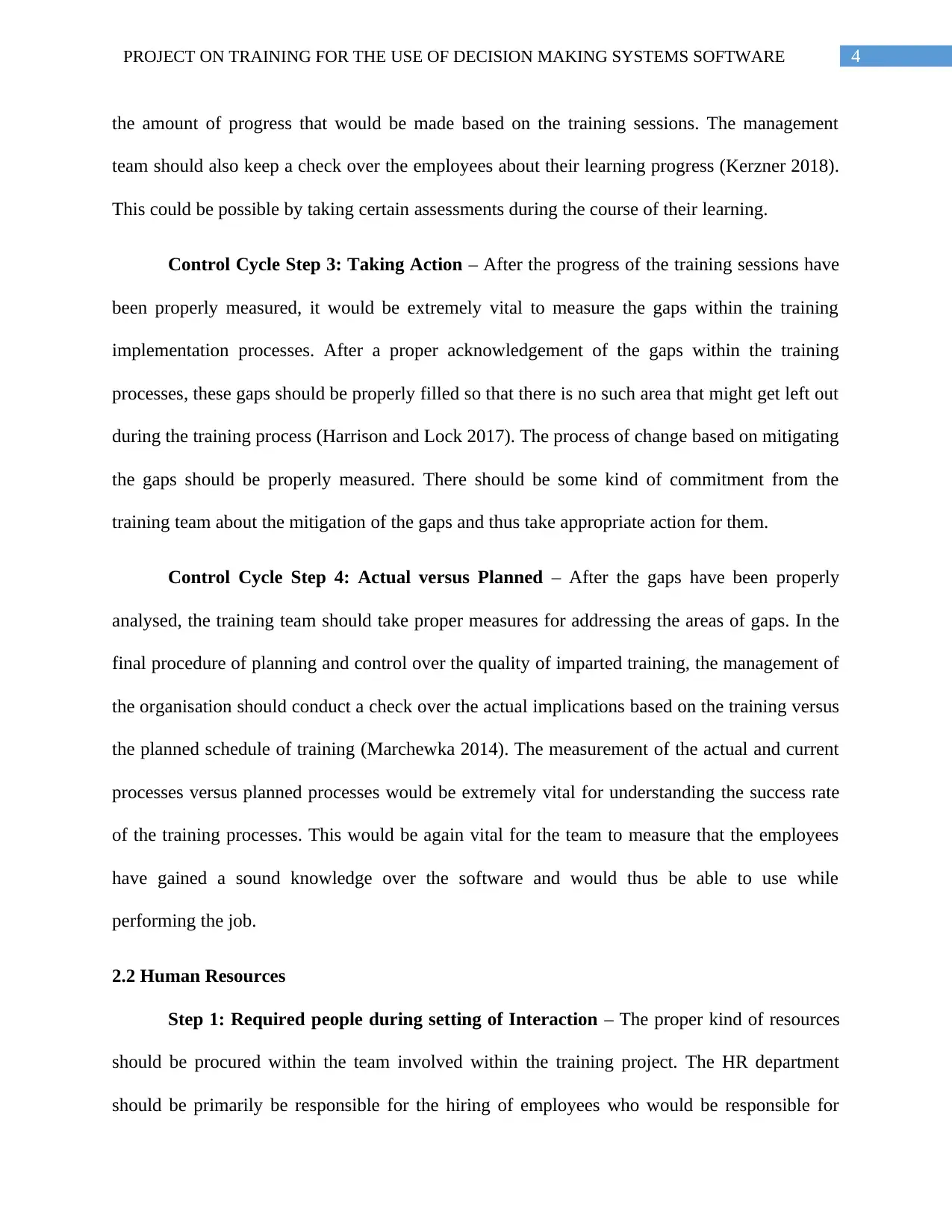
4PROJECT ON TRAINING FOR THE USE OF DECISION MAKING SYSTEMS SOFTWARE
the amount of progress that would be made based on the training sessions. The management
team should also keep a check over the employees about their learning progress (Kerzner 2018).
This could be possible by taking certain assessments during the course of their learning.
Control Cycle Step 3: Taking Action – After the progress of the training sessions have
been properly measured, it would be extremely vital to measure the gaps within the training
implementation processes. After a proper acknowledgement of the gaps within the training
processes, these gaps should be properly filled so that there is no such area that might get left out
during the training process (Harrison and Lock 2017). The process of change based on mitigating
the gaps should be properly measured. There should be some kind of commitment from the
training team about the mitigation of the gaps and thus take appropriate action for them.
Control Cycle Step 4: Actual versus Planned – After the gaps have been properly
analysed, the training team should take proper measures for addressing the areas of gaps. In the
final procedure of planning and control over the quality of imparted training, the management of
the organisation should conduct a check over the actual implications based on the training versus
the planned schedule of training (Marchewka 2014). The measurement of the actual and current
processes versus planned processes would be extremely vital for understanding the success rate
of the training processes. This would be again vital for the team to measure that the employees
have gained a sound knowledge over the software and would thus be able to use while
performing the job.
2.2 Human Resources
Step 1: Required people during setting of Interaction – The proper kind of resources
should be procured within the team involved within the training project. The HR department
should be primarily be responsible for the hiring of employees who would be responsible for
the amount of progress that would be made based on the training sessions. The management
team should also keep a check over the employees about their learning progress (Kerzner 2018).
This could be possible by taking certain assessments during the course of their learning.
Control Cycle Step 3: Taking Action – After the progress of the training sessions have
been properly measured, it would be extremely vital to measure the gaps within the training
implementation processes. After a proper acknowledgement of the gaps within the training
processes, these gaps should be properly filled so that there is no such area that might get left out
during the training process (Harrison and Lock 2017). The process of change based on mitigating
the gaps should be properly measured. There should be some kind of commitment from the
training team about the mitigation of the gaps and thus take appropriate action for them.
Control Cycle Step 4: Actual versus Planned – After the gaps have been properly
analysed, the training team should take proper measures for addressing the areas of gaps. In the
final procedure of planning and control over the quality of imparted training, the management of
the organisation should conduct a check over the actual implications based on the training versus
the planned schedule of training (Marchewka 2014). The measurement of the actual and current
processes versus planned processes would be extremely vital for understanding the success rate
of the training processes. This would be again vital for the team to measure that the employees
have gained a sound knowledge over the software and would thus be able to use while
performing the job.
2.2 Human Resources
Step 1: Required people during setting of Interaction – The proper kind of resources
should be procured within the team involved within the training project. The HR department
should be primarily be responsible for the hiring of employees who would be responsible for
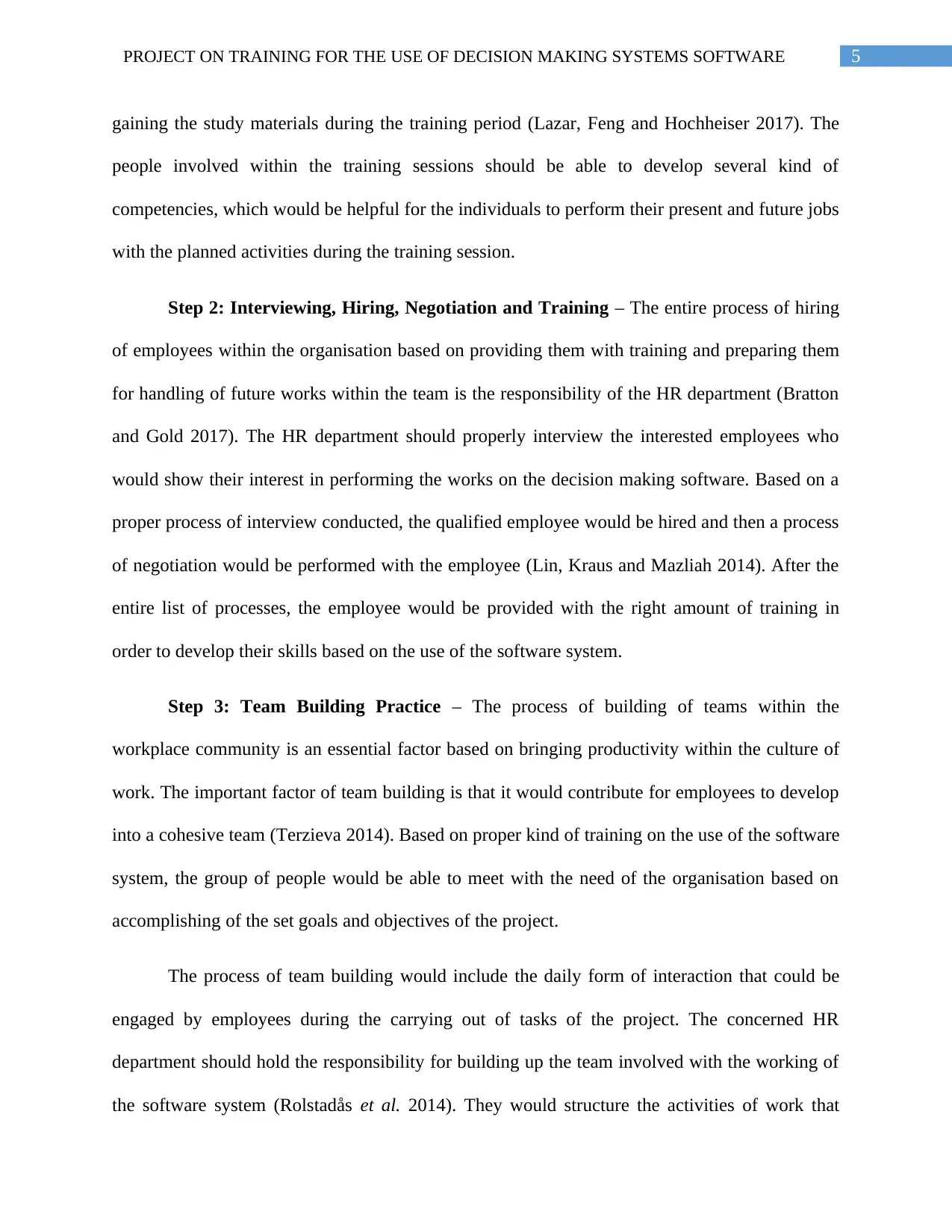
5PROJECT ON TRAINING FOR THE USE OF DECISION MAKING SYSTEMS SOFTWARE
gaining the study materials during the training period (Lazar, Feng and Hochheiser 2017). The
people involved within the training sessions should be able to develop several kind of
competencies, which would be helpful for the individuals to perform their present and future jobs
with the planned activities during the training session.
Step 2: Interviewing, Hiring, Negotiation and Training – The entire process of hiring
of employees within the organisation based on providing them with training and preparing them
for handling of future works within the team is the responsibility of the HR department (Bratton
and Gold 2017). The HR department should properly interview the interested employees who
would show their interest in performing the works on the decision making software. Based on a
proper process of interview conducted, the qualified employee would be hired and then a process
of negotiation would be performed with the employee (Lin, Kraus and Mazliah 2014). After the
entire list of processes, the employee would be provided with the right amount of training in
order to develop their skills based on the use of the software system.
Step 3: Team Building Practice – The process of building of teams within the
workplace community is an essential factor based on bringing productivity within the culture of
work. The important factor of team building is that it would contribute for employees to develop
into a cohesive team (Terzieva 2014). Based on proper kind of training on the use of the software
system, the group of people would be able to meet with the need of the organisation based on
accomplishing of the set goals and objectives of the project.
The process of team building would include the daily form of interaction that could be
engaged by employees during the carrying out of tasks of the project. The concerned HR
department should hold the responsibility for building up the team involved with the working of
the software system (Rolstadås et al. 2014). They would structure the activities of work that
gaining the study materials during the training period (Lazar, Feng and Hochheiser 2017). The
people involved within the training sessions should be able to develop several kind of
competencies, which would be helpful for the individuals to perform their present and future jobs
with the planned activities during the training session.
Step 2: Interviewing, Hiring, Negotiation and Training – The entire process of hiring
of employees within the organisation based on providing them with training and preparing them
for handling of future works within the team is the responsibility of the HR department (Bratton
and Gold 2017). The HR department should properly interview the interested employees who
would show their interest in performing the works on the decision making software. Based on a
proper process of interview conducted, the qualified employee would be hired and then a process
of negotiation would be performed with the employee (Lin, Kraus and Mazliah 2014). After the
entire list of processes, the employee would be provided with the right amount of training in
order to develop their skills based on the use of the software system.
Step 3: Team Building Practice – The process of building of teams within the
workplace community is an essential factor based on bringing productivity within the culture of
work. The important factor of team building is that it would contribute for employees to develop
into a cohesive team (Terzieva 2014). Based on proper kind of training on the use of the software
system, the group of people would be able to meet with the need of the organisation based on
accomplishing of the set goals and objectives of the project.
The process of team building would include the daily form of interaction that could be
engaged by employees during the carrying out of tasks of the project. The concerned HR
department should hold the responsibility for building up the team involved with the working of
the software system (Rolstadås et al. 2014). They would structure the activities of work that
⊘ This is a preview!⊘
Do you want full access?
Subscribe today to unlock all pages.

Trusted by 1+ million students worldwide
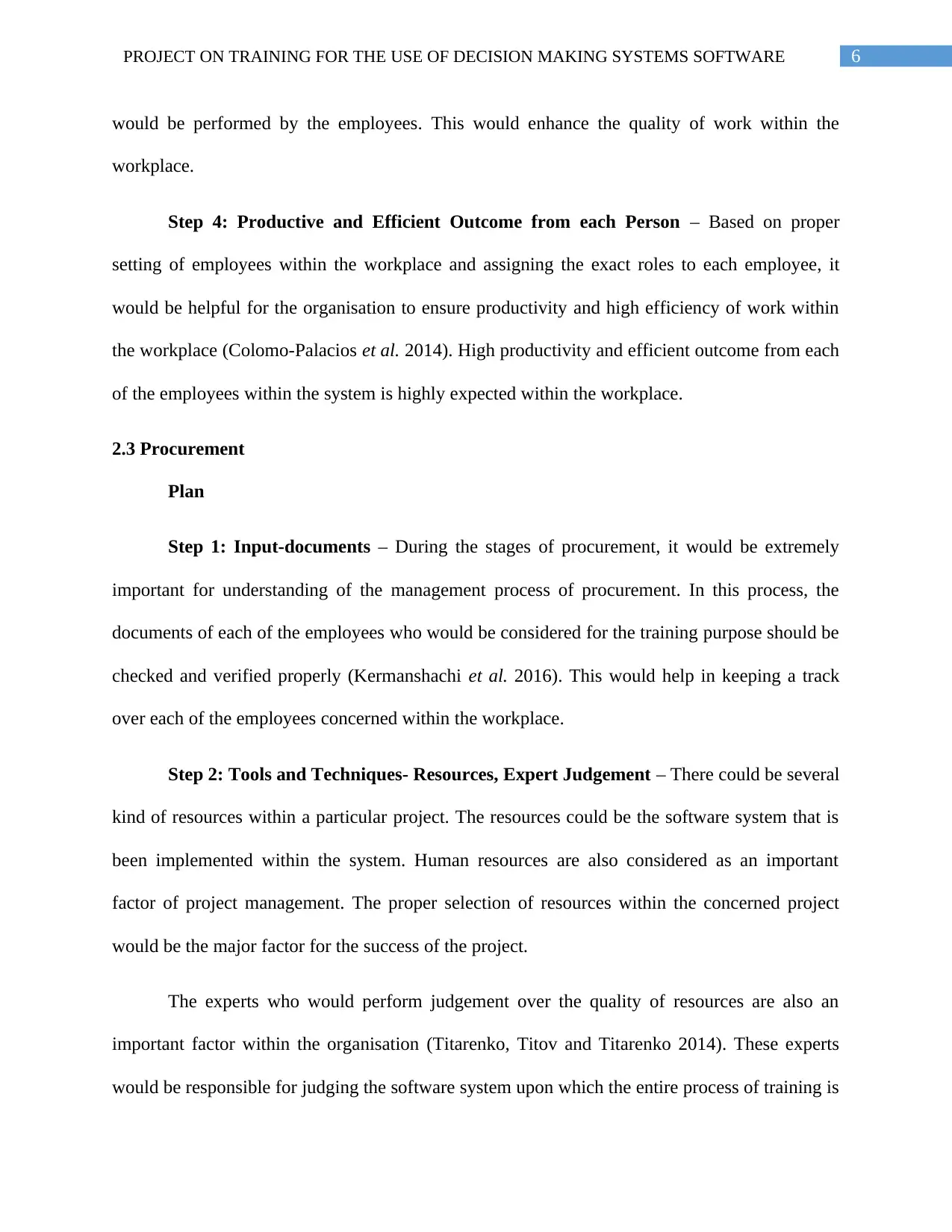
6PROJECT ON TRAINING FOR THE USE OF DECISION MAKING SYSTEMS SOFTWARE
would be performed by the employees. This would enhance the quality of work within the
workplace.
Step 4: Productive and Efficient Outcome from each Person – Based on proper
setting of employees within the workplace and assigning the exact roles to each employee, it
would be helpful for the organisation to ensure productivity and high efficiency of work within
the workplace (Colomo-Palacios et al. 2014). High productivity and efficient outcome from each
of the employees within the system is highly expected within the workplace.
2.3 Procurement
Plan
Step 1: Input-documents – During the stages of procurement, it would be extremely
important for understanding of the management process of procurement. In this process, the
documents of each of the employees who would be considered for the training purpose should be
checked and verified properly (Kermanshachi et al. 2016). This would help in keeping a track
over each of the employees concerned within the workplace.
Step 2: Tools and Techniques- Resources, Expert Judgement – There could be several
kind of resources within a particular project. The resources could be the software system that is
been implemented within the system. Human resources are also considered as an important
factor of project management. The proper selection of resources within the concerned project
would be the major factor for the success of the project.
The experts who would perform judgement over the quality of resources are also an
important factor within the organisation (Titarenko, Titov and Titarenko 2014). These experts
would be responsible for judging the software system upon which the entire process of training is
would be performed by the employees. This would enhance the quality of work within the
workplace.
Step 4: Productive and Efficient Outcome from each Person – Based on proper
setting of employees within the workplace and assigning the exact roles to each employee, it
would be helpful for the organisation to ensure productivity and high efficiency of work within
the workplace (Colomo-Palacios et al. 2014). High productivity and efficient outcome from each
of the employees within the system is highly expected within the workplace.
2.3 Procurement
Plan
Step 1: Input-documents – During the stages of procurement, it would be extremely
important for understanding of the management process of procurement. In this process, the
documents of each of the employees who would be considered for the training purpose should be
checked and verified properly (Kermanshachi et al. 2016). This would help in keeping a track
over each of the employees concerned within the workplace.
Step 2: Tools and Techniques- Resources, Expert Judgement – There could be several
kind of resources within a particular project. The resources could be the software system that is
been implemented within the system. Human resources are also considered as an important
factor of project management. The proper selection of resources within the concerned project
would be the major factor for the success of the project.
The experts who would perform judgement over the quality of resources are also an
important factor within the organisation (Titarenko, Titov and Titarenko 2014). These experts
would be responsible for judging the software system upon which the entire process of training is
Paraphrase This Document
Need a fresh take? Get an instant paraphrase of this document with our AI Paraphraser

7PROJECT ON TRAINING FOR THE USE OF DECISION MAKING SYSTEMS SOFTWARE
dependent. Based on the suggestions and recommendation of experts, the entire process of
procurement would be considered for further progress.
Step 3: Outputs-Strategies – Each of the strategies based on the work of the project or
the imparting of training procedures should be properly planned (Edler and Yeow 2016).
Strategies should be developed in order to provide the best kind of training sessions to the
employees based on their use of the systems.
Control
Step 1: Input- Performance – High kind of performance should be delivered by the
training team based on imparting training to the candidates. The performance of each of the
employees should be properly assessed after the completion of the training period (Papke-Shields
and Boyer-Wright 2017). This would be highly essential for the management to decide whether
the employees would be considered to be fit for performing on-job work on the live system.
Step 2: Tools and Techniques- Inspection – High level of inspection on the employees
should be conducted by the management over the employees (Parker, Parsons and Isharyanto
2015). They should check whether the training is being conducted in a successful manner or if
there is any other kind of problem that might be faced by the employee during the period of
training. Based on proper knowledge of the concerning issues,
Step 3: Outputs – Based on performing a thorough analysis over the entire scenario of
training session, the outputs at the end of the training session would be considered for reviewal.
The outputs for the training could be measured based on the performance of the employees when
they would perform their job based on dealing with live projects (Alias et al. 2014). High outputs
dependent. Based on the suggestions and recommendation of experts, the entire process of
procurement would be considered for further progress.
Step 3: Outputs-Strategies – Each of the strategies based on the work of the project or
the imparting of training procedures should be properly planned (Edler and Yeow 2016).
Strategies should be developed in order to provide the best kind of training sessions to the
employees based on their use of the systems.
Control
Step 1: Input- Performance – High kind of performance should be delivered by the
training team based on imparting training to the candidates. The performance of each of the
employees should be properly assessed after the completion of the training period (Papke-Shields
and Boyer-Wright 2017). This would be highly essential for the management to decide whether
the employees would be considered to be fit for performing on-job work on the live system.
Step 2: Tools and Techniques- Inspection – High level of inspection on the employees
should be conducted by the management over the employees (Parker, Parsons and Isharyanto
2015). They should check whether the training is being conducted in a successful manner or if
there is any other kind of problem that might be faced by the employee during the period of
training. Based on proper knowledge of the concerning issues,
Step 3: Outputs – Based on performing a thorough analysis over the entire scenario of
training session, the outputs at the end of the training session would be considered for reviewal.
The outputs for the training could be measured based on the performance of the employees when
they would perform their job based on dealing with live projects (Alias et al. 2014). High outputs

8PROJECT ON TRAINING FOR THE USE OF DECISION MAKING SYSTEMS SOFTWARE
would benefit the organisation and would lead to satisfaction of the trainers based on their effort
during the training period.
2.4 Communications
Step 1: Sender – There should be a proper level of communication between the sender of
a message and the receiver of a message. In the concerned training implementation project, the
training provider should establish a proper level of communication between them and the
employees who are being imparted with the training. In the concerned scenario, there could be
other different kind of sender of messages (Braglia and Frosolini 2014). They would be solely be
responsible for providing the right form of message to the concerned employees.
Step 2: Message – The communication between the sender and the receiver would be
through the help of messages. The importance of messages is highly understood during the
communication phase. In the project based on training implementation, a proper kind of
communication of messages in extremely vital for gaining a vast knowledge over the use of
decision making systems software. The messages should be clear and appropriate in order to be
understandable by the receiver of the messages.
Step 3: Receiver – The receiver of the message can also be considered as another
important person or individual who would be responsible for understanding the received
message. This individual would understand the message and thus perform the next phase of work
based on the message. In the concerned project, each of the receivers of the messages would
have to stay active at all times (Špundak 2014). They should be aware of the received messages
and thus plan accordingly. If the concerned message is any form of instruction, then they should
perform accordingly. This would further inculcate a high level of communication medium
within the workplace and also inherit many kind of benefits within the system.
would benefit the organisation and would lead to satisfaction of the trainers based on their effort
during the training period.
2.4 Communications
Step 1: Sender – There should be a proper level of communication between the sender of
a message and the receiver of a message. In the concerned training implementation project, the
training provider should establish a proper level of communication between them and the
employees who are being imparted with the training. In the concerned scenario, there could be
other different kind of sender of messages (Braglia and Frosolini 2014). They would be solely be
responsible for providing the right form of message to the concerned employees.
Step 2: Message – The communication between the sender and the receiver would be
through the help of messages. The importance of messages is highly understood during the
communication phase. In the project based on training implementation, a proper kind of
communication of messages in extremely vital for gaining a vast knowledge over the use of
decision making systems software. The messages should be clear and appropriate in order to be
understandable by the receiver of the messages.
Step 3: Receiver – The receiver of the message can also be considered as another
important person or individual who would be responsible for understanding the received
message. This individual would understand the message and thus perform the next phase of work
based on the message. In the concerned project, each of the receivers of the messages would
have to stay active at all times (Špundak 2014). They should be aware of the received messages
and thus plan accordingly. If the concerned message is any form of instruction, then they should
perform accordingly. This would further inculcate a high level of communication medium
within the workplace and also inherit many kind of benefits within the system.
⊘ This is a preview!⊘
Do you want full access?
Subscribe today to unlock all pages.

Trusted by 1+ million students worldwide

9PROJECT ON TRAINING FOR THE USE OF DECISION MAKING SYSTEMS SOFTWARE
Step 4: Feedback – After a proper communication channel have been established, there
would be a high need for gaining feedback from both the sender and the receiver of the message.
An effective form of feedback such as negative or positive would be considered to be extremely
helpful. Based on the gained feedbacks, it would be extremely useful for the management team
to decide on the best form of possible actions that could be taken to improvise the systems. The
generation of feedback would be able to ensure that the communication channel was clear and
there was no disturbance in the channel. This would also help the management team to
understand the ways in which the communication channel could further be enhanced in order to
ensure a better quality of work output (Reed et al. 2014). Based on proper form of feedback from
the employees, there could be a continuous form of improvement process. The feedback from
each of the individuals within the organisation would be the prime factor of consideration based
on bringing improvement in the processes and thus also increasing the efficiency of the
workplace.
2.5 Stakeholders
Step 1: Individual, Group, and Organisation – A stakeholder could be considered as
the most important factor within the project. The stakeholders who would be involved within the
project would mainly be impacted based on the outcomes of the project. The involved
stakeholders within the project would have a major interest based on the success of the project
(Davis 2014). The different stakeholders involved within the project might be within the
organisation or they might be some who would be sponsoring the entire implementation of the
project.
In this scenario of training implementation project, there would be many people who
would be involved within the project scenario. The management organisation would be
Step 4: Feedback – After a proper communication channel have been established, there
would be a high need for gaining feedback from both the sender and the receiver of the message.
An effective form of feedback such as negative or positive would be considered to be extremely
helpful. Based on the gained feedbacks, it would be extremely useful for the management team
to decide on the best form of possible actions that could be taken to improvise the systems. The
generation of feedback would be able to ensure that the communication channel was clear and
there was no disturbance in the channel. This would also help the management team to
understand the ways in which the communication channel could further be enhanced in order to
ensure a better quality of work output (Reed et al. 2014). Based on proper form of feedback from
the employees, there could be a continuous form of improvement process. The feedback from
each of the individuals within the organisation would be the prime factor of consideration based
on bringing improvement in the processes and thus also increasing the efficiency of the
workplace.
2.5 Stakeholders
Step 1: Individual, Group, and Organisation – A stakeholder could be considered as
the most important factor within the project. The stakeholders who would be involved within the
project would mainly be impacted based on the outcomes of the project. The involved
stakeholders within the project would have a major interest based on the success of the project
(Davis 2014). The different stakeholders involved within the project might be within the
organisation or they might be some who would be sponsoring the entire implementation of the
project.
In this scenario of training implementation project, there would be many people who
would be involved within the project scenario. The management organisation would be
Paraphrase This Document
Need a fresh take? Get an instant paraphrase of this document with our AI Paraphraser

10PROJECT ON TRAINING FOR THE USE OF DECISION MAKING SYSTEMS SOFTWARE
responsible for deciding on several factors based on the implementation of the training and their
future outcomes. Other stakeholders would also include the persons who have installed the
software system within the computer systems (Biesenthal and Wilden 2014). These individuals
would be mostly affected based on the success or failure rate of the project. These stakeholders
would be responsible for defining the most appropriate strategies that would be needed to be
taken in order to manage each of the training aspects into consideration. The imparted training on
the use of the software system would be considered as the most deciding factor for the success of
the project.
Step 2: Effected by project, effected to project – In the current scenario of the project,
the primary persons who are considered as the stakeholders of the project are: The Managers
within the organisation, the people involved during the installation of the software system and
the training committee who would impart training on the use of the software systems. These
individuals would be directly affected by the end of the project.
During the imparting of training to the employees based on using the new software
system, every single aspect would be taken into prime consideration. The training committee
would manage the entire setup list of tasks and activities that would be conducted during the
training period. The training sessions would be inculcated in such a manner that they would be
able to make the employees to be experts in using the systems (Mazur et al. 2014). Based on
providing of the training, the employees would be able to prove themselves to be effective based
on the learning of new kind of systems. The use of the decision making software system would
prove to be majorly effective in making of essential decisions.
The management team would also be affected based on the success rate if the training
sessions. Based on the successful learning of the employees, they would be able to provide their
responsible for deciding on several factors based on the implementation of the training and their
future outcomes. Other stakeholders would also include the persons who have installed the
software system within the computer systems (Biesenthal and Wilden 2014). These individuals
would be mostly affected based on the success or failure rate of the project. These stakeholders
would be responsible for defining the most appropriate strategies that would be needed to be
taken in order to manage each of the training aspects into consideration. The imparted training on
the use of the software system would be considered as the most deciding factor for the success of
the project.
Step 2: Effected by project, effected to project – In the current scenario of the project,
the primary persons who are considered as the stakeholders of the project are: The Managers
within the organisation, the people involved during the installation of the software system and
the training committee who would impart training on the use of the software systems. These
individuals would be directly affected by the end of the project.
During the imparting of training to the employees based on using the new software
system, every single aspect would be taken into prime consideration. The training committee
would manage the entire setup list of tasks and activities that would be conducted during the
training period. The training sessions would be inculcated in such a manner that they would be
able to make the employees to be experts in using the systems (Mazur et al. 2014). Based on
providing of the training, the employees would be able to prove themselves to be effective based
on the learning of new kind of systems. The use of the decision making software system would
prove to be majorly effective in making of essential decisions.
The management team would also be affected based on the success rate if the training
sessions. Based on the successful learning of the employees, they would be able to provide their
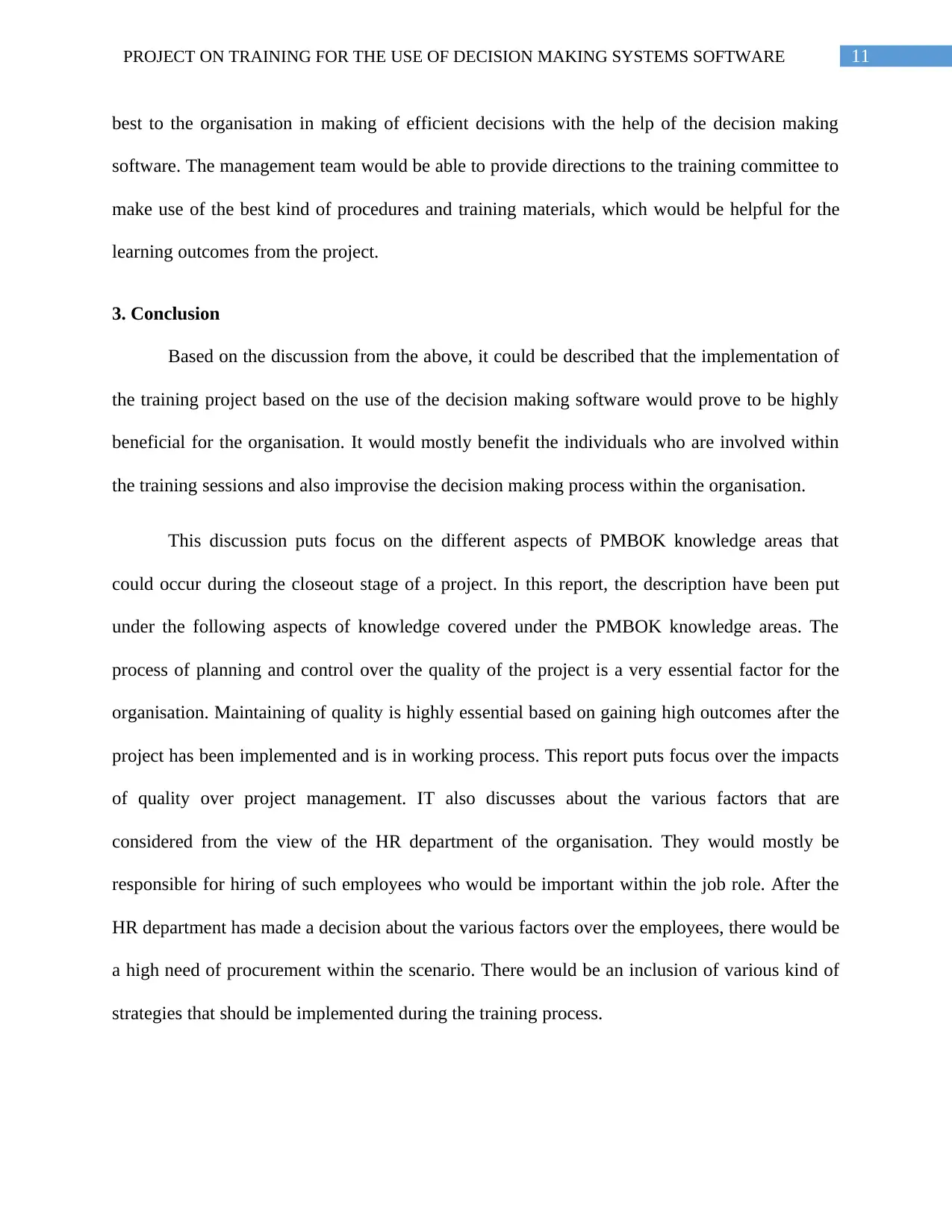
11PROJECT ON TRAINING FOR THE USE OF DECISION MAKING SYSTEMS SOFTWARE
best to the organisation in making of efficient decisions with the help of the decision making
software. The management team would be able to provide directions to the training committee to
make use of the best kind of procedures and training materials, which would be helpful for the
learning outcomes from the project.
3. Conclusion
Based on the discussion from the above, it could be described that the implementation of
the training project based on the use of the decision making software would prove to be highly
beneficial for the organisation. It would mostly benefit the individuals who are involved within
the training sessions and also improvise the decision making process within the organisation.
This discussion puts focus on the different aspects of PMBOK knowledge areas that
could occur during the closeout stage of a project. In this report, the description have been put
under the following aspects of knowledge covered under the PMBOK knowledge areas. The
process of planning and control over the quality of the project is a very essential factor for the
organisation. Maintaining of quality is highly essential based on gaining high outcomes after the
project has been implemented and is in working process. This report puts focus over the impacts
of quality over project management. IT also discusses about the various factors that are
considered from the view of the HR department of the organisation. They would mostly be
responsible for hiring of such employees who would be important within the job role. After the
HR department has made a decision about the various factors over the employees, there would be
a high need of procurement within the scenario. There would be an inclusion of various kind of
strategies that should be implemented during the training process.
best to the organisation in making of efficient decisions with the help of the decision making
software. The management team would be able to provide directions to the training committee to
make use of the best kind of procedures and training materials, which would be helpful for the
learning outcomes from the project.
3. Conclusion
Based on the discussion from the above, it could be described that the implementation of
the training project based on the use of the decision making software would prove to be highly
beneficial for the organisation. It would mostly benefit the individuals who are involved within
the training sessions and also improvise the decision making process within the organisation.
This discussion puts focus on the different aspects of PMBOK knowledge areas that
could occur during the closeout stage of a project. In this report, the description have been put
under the following aspects of knowledge covered under the PMBOK knowledge areas. The
process of planning and control over the quality of the project is a very essential factor for the
organisation. Maintaining of quality is highly essential based on gaining high outcomes after the
project has been implemented and is in working process. This report puts focus over the impacts
of quality over project management. IT also discusses about the various factors that are
considered from the view of the HR department of the organisation. They would mostly be
responsible for hiring of such employees who would be important within the job role. After the
HR department has made a decision about the various factors over the employees, there would be
a high need of procurement within the scenario. There would be an inclusion of various kind of
strategies that should be implemented during the training process.
⊘ This is a preview!⊘
Do you want full access?
Subscribe today to unlock all pages.

Trusted by 1+ million students worldwide
1 out of 16
Related Documents
Your All-in-One AI-Powered Toolkit for Academic Success.
+13062052269
info@desklib.com
Available 24*7 on WhatsApp / Email
![[object Object]](/_next/static/media/star-bottom.7253800d.svg)
Unlock your academic potential
Copyright © 2020–2025 A2Z Services. All Rights Reserved. Developed and managed by ZUCOL.





